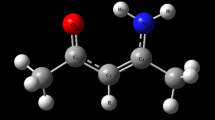Abstract
Hydrogen bonding interactions of organic radicals are systematically studied using diverse ab initio and density functional theory (DFT) methods. It is found that open-shell hydrogen bonds with radical proton donors are more difficult to model than those with radical proton acceptors. The DFT methods perform significantly worse than the unrestricted second order Möller-Plesset perturbation (UMP2) method in both geometry optimization and interaction energy calculations for the open-shell hydrogen bonds. The UB3LYP method seriously underestimates the donor-acceptor distances and overestimates interaction energies for the open-shell hydrogen bonds with radical proton donors. Nevertheless, use of the UBH&HLYP functional to study the open-shell hydrogen bonds is still acceptable. Furthermore, it is necessary to use sufficiently flexible basis sets, such as 6-311++G(2df,2p), to get reliable interaction energies for the open-shell hydrogen bonds. The open-shell proton donors are stronger Lewis acids than the corresponding closed-shell proton donors. The open-shell proton acceptors are weaker Lewis bases than the corresponding closed-shell proton acceptors.
Similar content being viewed by others
References
Scheiner, S. Hydrogen Bonding; Oxford University Press, New York, 1997.
Some recent interesting reviews: (a) Qi, Z.-Q.; Shao, X.-B.; Zhao, X.; Li, X.-Q.; Wang, X.-Z.; Zhang, W.-X.; Jiang, X.-K.; Li, Z.-T. Chin. J. Org. Chem. 2003, 23, 403. (b) Karpfen, A. Adv. Chem. Phys. 2002, 123, 469. (c) Dannenberg, J. J. J. Mol. Struct. 2002, 615, 219. (d) Steiner, T. Angew. Chem. Int. Ed. 2002, 41, 48. (e) Henri-Rousseau, O.; Blaise, P.; Chamma, D. Adv. Chem. Phys. 2002, 121, 241. (f) Sponer, J. V.; Leszczynski, J.; Hobza, P. Theochem 2001, 573, 43.
Some examples: (a) De Visser, S. P.; Shaik, S. J. Am. Chem. Soc. 2003, 125, 7413. (b) Grimaldi, S.; Ostermann, T.; Weiden, N.; Mogi, T.; Miyoshi, H.; Ludwig, B.; Michel, H.; Prisner, T. F.; MacMillan, F. Biochemistry 2003, 42, 5632. (c) Whittaker, J. W. Chem. Rev. 2003, 103, 2347.
Some examples: (a) Gray, M.; Goodman, A. J.; Carroll, J. B.; Bardon, K.; Markey, M.; Cooke, G.; Rotello, V. M. Org. Lett. 2004, 6, 385. (b) Tan, L.; Chen, S.-M.; Yan, X.-M.; Ping, Z.-H.; Shen, Y.-M. Chem. J. Chin. Univ. 2003, 24, 1114. (c) Lucarini, M.; Mugnaini, V.; Pedulli, G. F.; Guerra, M. J. Am. Chem. Soc. 2003, 125, 8318. (d) Wang, L.-F.; Zhang, H.-Y. Chin. J. Chem. 2003, 21, 1669.
(a) Espinosa-Garcia, J. J. Am. Chem. Soc. 2004, 126, 920. (b) Chen, D.-Z.; Yang, Z.-N.; Wang, D.-P.; Meng, L. Acta Chim. Sin. 2003, 61, 1213. (c) Yu, H.-T.; Chi, Y.-J.; Fu, H.-G.; Li, Z.-S.; Sun, J.-Z. Chin. J. Chem. 2003, 21, 244. (d) Ramirez-Arizmendi, L. E.; Heidbrink, J. L.; Guler; L. P.; Kenttaemaa, H. I. J. Am. Chem. Soc. 2003, 125, 2272.
(a) Dorlet, P.; Seibold, S. A.; Babcock, G. T.; Gerfen, G. J.; Smith, W. L.; Tsai, A.; Un, S. Biochemistry 2002, 41, 6107. (b) Song, J. K.; Lee, N. K.; Kim, S. K. J. Chem. Phys. 2002, 117, 1589. (c) Fujii, A.; Ebata, T.; Mikami, M. J. Phys. Chem. A 2002, 106, 8554.
Recent examples: (a) Dibble, T. S. J. Phys. Chem. A 2004, 108, 2199. (b) Fu, H.; Zhou, Z.; Zhou, X. Chem. Phys. Lett. 2003, 382, 466. (d) Wang, B.-Q.; Li, Z.-R.; Wu, D.; Hao, X.-Y.; Li, R.-J.; Sun, C.-C. Chem. Phys. Lett. 2003, 375, 91. (e) Lucarini, M.; Mugnaini, V.; Pedulli, G. F.; Guerra, M. J. Am. Chem. Soc. 2003, 125, 8318. (f) Zheng, W.-X.; Pu, X.-M.; Wang, X.-Z.; Tian, A.-M. Acta Chim. Sin. 2003, 61, 336.
Frisch, M. J.; Trucks, G. W.; Schlegel, H. B.; Scuseria, G. E.; Robb, M. A.; Cheeseman, J. R. Montgomery, J. A., Jr.; Vreven, T.; Kudin, K. N.; Burant, J. C.; Millam, J. M.; Iyengar, S. S.; Tomasi, J.; Barone, V.; Mennucci, B.; Cossi, M.; Scalmani, G.; Rega, N.; Petersson, G. A.; Nakatsuji, H.; Hada, M.; Ehara, M.; Toyota, K.; Fukuda, R.; Hasegawa, J.; Ishida, M.; Nakajima, T.; Honda, Y.; Kitao, O.; Nakai, H.; Klene, M.; Li, X.; Knox, J. E.; Hratchian, H. P.; Cross, J. B.; Adamo, C.; Jaramillo, J.; Gomperts, R.; Stratmann, R. E.; Yazyev, O.; Austin, A. J.; Cammi, R.; Pomelli, C.; Ochterski, J. W.; Ayala, P. Y.; Morokuma, K.; Voth, G. A.; Salvador, P.; Dannenberg, J. J.; Zakrzewski, V. G.; Dapprich, S.; Daniels, A. D.; Strain, M. C.; Farkas, O.; Malick, D. K.; Rabuck, A. D.; Raghavachari, K.; Foresman, J. B.; Ortiz, J. V.; Cui, Q.; Baboul, A. G.; Clifford, S.; Cioslowski, J.; Stefanov, B. B.; Liu, G.; Liashenko, A.; Piskorz, P.; Komaromi, I.; Martin, R. L.; Fox, D. J.; Keith, T.; Al-Laham, M. A.; Peng, C. Y. Nanayakkara, A.; Challacombe, M.; Gill, P. M. W.; Johnson, B.; Chen, W.; Wong, M. W.; Gonzalez, C.; Pople, J. A. Gaussian 03, revision A.1; Gaussian, Inc.: Pittsburgh, PA, 2003.
(a) Boys, S. F.; Bernardi, F. Mol. Phys. 1970, 19, 553. (b) Wang, W.-Z.; Pu, X.-M.; Zheng, W.-X.; Wong, N.-B.; Tian, A.-M. Chin. J. Chem. 2003, 21, 1586.
For a nice description of the disperson force problem, please read: Zimmerli, U.; Parrinello, M.; Koumoutsako, P. J. Chem. Phys. 2004, 120, 2693.
Author information
Authors and Affiliations
Corresponding authors
Rights and permissions
About this article
Cite this article
Qi, XJ., Liu, L., Fu, Y. et al. Hydrogen Bonding Interactions of Radicals. Struct Chem 16, 347–353 (2005). https://doi.org/10.1007/s11224-005-4465-6
Received:
Revised:
Accepted:
Issue Date:
DOI: https://doi.org/10.1007/s11224-005-4465-6




